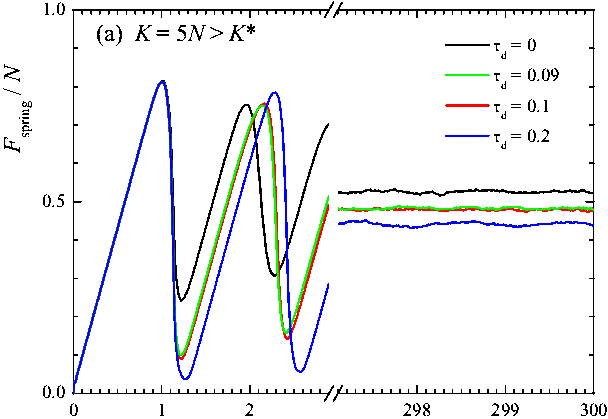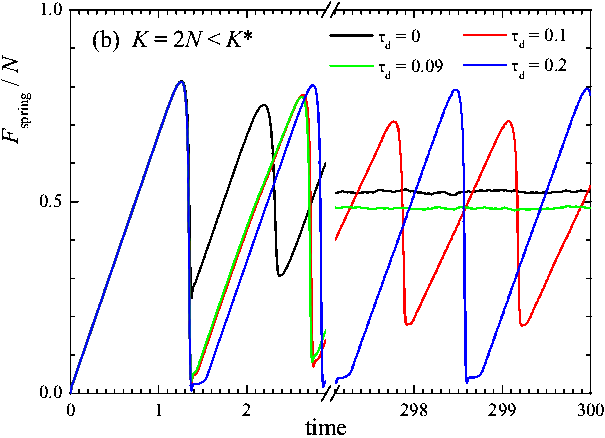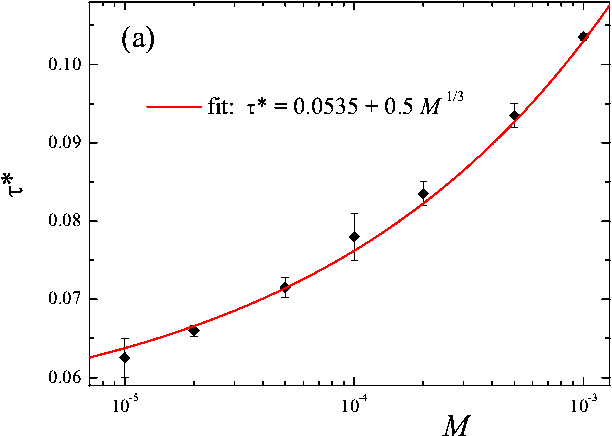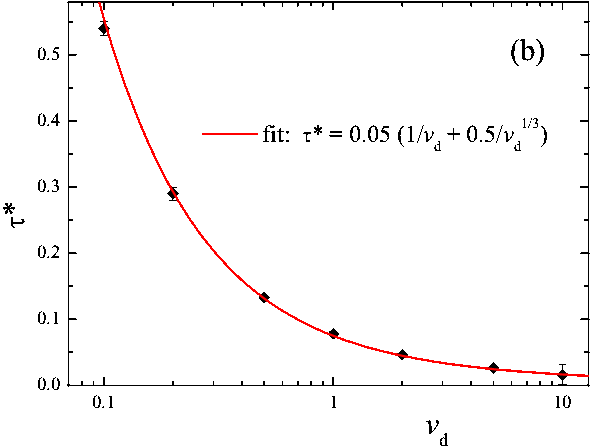Using the earthquakelike model, we describe the conditions when stick-slip appears, and consider transitions between the stick-slip and smooth sliding regimes for the multicontact frictional interface.
We use the EQ model and assume that the distribution Pc(x) is Gaussian centered at x = xs= fs/k with a dispersion Δxs= Δfs/k. A typical dependence of the total force Fc from the contacts on the slider displacement X is shown in Fig.1. Except the exotic case of delta-function distribution of thresholds, the function Fc(X) always approaches the constant value Fk≈ 0.5 Nfs in the limit X → ∞; the value Fk corresponds to the kinetic friction force, while the maximum of the Fc(X) dependence is associated with the static friction force. We emphasize that the shape of the function Fc(X) depends not only on the dispersion of the distribution Pc(x), but also on the initial distribution Qi(f) of the system: the strongest initial oscillations of Fc(X) are achieved for the delta-function initial distribution Qi(f) = δ(f), while in the case of Qi(f) = Qs(f) (the stationary distribution) the force is independent of X, Fc(X) = Fk.
|
|
Figure 1: Rigid motion of the
slider: the total force from contacts Fc as
function of the slider displacement X for two initial
distributions Δf0/fs =
0.01 and 0.3 and two values of the threshold distribution Δfs/fs
= 0.1 and 0.3 (see legend). Solid curves describe solutions of the ME,
dotted curves show results of simulation of the EQ model with N =
103 contacts; the latter fluctuates with the amplitude ∝
N
|
Now let us consider a system where the top block is driven with a velocity vd through a spring of elastic constant K so that the driving force is Fd= K (vdt − X); the role of spring may be played by the elasticity of the slider itself, if the driving force is applied to its top surface. For adiabatically slow driving, vd→ 0, if one starts from the relaxed state at t = 0, the increasing driving force Fd has to be compensated by the force Fc from the interface contacts, so that they grow together at the beginning. However, when the slider displacement X approaches the threshold value xs= fs/k, the contacts start to break (see the point marked by "1" in Fig.2), the growth of Fc becomes slower and then changes to decreasing as shown in Fig.2. If the driving spring (or the slider) is stiff enough, K > K*, the driving force Fd will adjust itself to the changed value of Fc. For a soft system, however, at some point X* (marked by "2" in Fig.2) the two forces cannot compensate one another, an elastic instability occurs, and the slider will undergo an accelerated motion until the forces will compensate one another again.
|
|
Figure 2: Elastic instability.
|
|
(8) |
|
|
|
|
|
Figure 3: The critical stiffness K* as function of the threshold dispersion Δfs for different values of the initial state distribution Δf0.
|
|
However, the elastic instability is the necessary but not sufficient condition for stick-slip to appear; the second necessary condition is the aging of contacts − an increase of contact thresholds with their timelife. Indeed, if after breaking the newborn contacts obtain thresholds from the same distribution Pc(f), then the dependence Fc(X) will be the same too, and the scenario will not change despite the fact that the slider motion is accelerated for X where Keff (X) > K* as demonstrated in Fig.4.
|
|
Figure 4: Dependence of the spring force Fd= K (vdt −X) (solid) and the slider velocity dX/dt (dotted curves, right axes) on the slider displacement X for two values of the spring constant: K/N = 5 (above the critical value K*/N = 3.59) and K/N = 2 (when the elastic instability occurs).
Parameters: fs= 1, Δfs= 0.1, Δf0= 0.01,
k = 1, vd= 1, M/N = 10
|
|
(9) |
|
 |
 |
|
Figure 5: Dependence of the spring force Fd on time for different values of the delay time τd= 0, 0.09, 0.1 and 0.2 (see legend) for two values of the spring constant: (a) K/N = 5 and (b) K/N = 2. Other parameters as in Fig.4. |
|
Figure 5 shows that for a large
enough delay time τd > τ* the slider motion
corresponds to stick-slip provided K < K*. Note also
that for smooth sliding the kinetic friction decreases when τd
increases, Fk ∝ (1 + v/vd)
|
|
Figure 6: System dynamics at/after the elastic instability for K/N = 2 and τd= ∞ (other parameters as in Fig.4).
|
|
(10) |
 |
 |
|
Figure 7:
(a) The critical delay time τ* as function of the slider
mass M at constant vd=1, and
(b) τ* as function of the driving velocity vd
at fixed M = 10 |
|
The critical delay time τ*
may be estimated from Eq.(10); for Ωτ*<< 1 this gives τ*≈ Δfs/kvd,
while for Ωτ*>> 1 it leads to a relation τ*≈
(6ΔfsM / kKvd)1/3.
These relations agree well with the numerics (see Fig.7) which suggests the
dependences τ*(M) ≈ A1+ A2M 1/3
and τ*(vd) ≈ A3vd
|
|
Figure 8: The friction force as function of time, when the driving velocity vd (thick red line, right axes) continuously increases/decreases with time for fixed value of the delay time τd= 0.1.
Insets show the smooth to stick-slip transition at v1~ 1.8 when vd increases (left), and the stick-slip to smooth sliding transition at v1'~ 0.55 when vd decreases (right).
K/N = 2, M = 10
|
The simplest "delay time" variant of aging predicts the transition from smooth sliding to stick-slip with the growth of the driving velocity, which indeed was observed experimentally. More traditional, however, is the opposite scenario, when smooth sliding is observed at low vd and changes to smooth sliding when the driving velocity increases. Such a scenario can be described if we include aging of the contacts. Indeed, the threshold value of the contact after its breaking/restoring should grow with the time of stationary contact due to its aging, e.g., because of plastic deformations at the level of contacts or a slow formation of chemical bonds.
|
(11) |
|
(12) |
|
(13) |
|
(14) |
|
(15) |
|
(16) |
|
|
Figure 9: Rigid motion of the slider. The total force from contacts Fc as function of the slider displacement X for different values of the aging rate β = 0, 1, 3 and 10 (see legend); dotted curve corresponds to motion without aging (Fig.1).
fs= 1, Δfs= 0.1, Δf0= 0.01, k = 1, and N = 2×103.
|
The friction force as a function of the slider displacement X for the rigid motion of the slider is shown in Fig.9. One can see that the effective stiffness K* does not change significantly with β, while the stationary state at X → ∞ essentially depends on the aging rate β; the latter corresponds to smooth sliding and may be found analytically.
|
|
Figure 10: The friction force versus time for different values of the aging rate β (see legend); stick-slip exists for the rates within the interval 1 ≤ β ≤ 1.6.
K/N = 1, M = 10
|
If now one will drive the slider through an attached spring, then the motion may correspond to either stick-slip or smooth sliding depending on the rate β; the stick-slip regime appears for the rates within some interval β1 ≤ β ≤ β2, while for smaller or larger values of β the motion is smooth (see Fig.10).
|
|
Figure 11: The friction force as function of time, when the driving velocity vd (thick red line, right axes) continuously increases/decreases with time.
The insets show the smooth to stick-slip transition at v1 and the stick-slip to smooth sliding transition at v2 when vd increases.
β = 1.5, other parameters as in Fig.10.
|
Thus, when the driving velocity continuously grows, the system should undergo
two transitions, the smooth to stick-slip transition at v1
and the stick-slip to smooth sliding transition at v2; if then
vd decreases, one again observes two transitions at v2'
and v1' (see Fig.11). The critical velocities v1
and v2 depend on the aging rate β as shown in
Fig.12. The first transition at v1 may be explained in the
same way as above: the stick-slip occurs when τd > τ*
(provided the instability criterion is satisfied), where now τd∝
β
|
|
Figure 12: The critical velocities v1 and v2 as functions of the aging rate β. Solid curves show fits v ∝ β2.
The parameters as in Fig.11.
|
|
|
Figure 13: The friction force (a) and the effective stiffness Keff as functions of the driving velocity vd for the aging rate β = 1.
The parameters are as in Fig.11.
|
Thus, the stick-slip emerges because of two factors, both of which are the necessary conditions. First, it must be the elastic instability. Second, it must be aging of the interface − the growth of the static thresholds with the timelife of a stationary contact. The first factor is controlled by the dispersion Δfs of the distribution Pc(f) of static thresholds. Therefore, using the interface with a large value of Δfs/fs, one may avoid the elastic instability and thus stick-slip. Besides, the value K* also depends on the distribution of stretchings in the initial state − if one starts with the stationary distribution Qs(f), the system would stay in the smooth-sliding regime forever. Because of the second factor − the contact aging − the stick-slip exists only for an interval of sliding velocities v1 < vd < v2 (which is in agreement, at least on a qualitative level, with experimental results, as demonstrated in Fig.14); both critical velocities v1,2 depend on the aging rate β as v1,2∝ β 2. Therefore, the stick-slip may also be avoided by an appropriate choice of the operating velocities.
|
|
Figure 14: Experimental results: the friction force (red), load (blue) and driving velocity (black, right axes) versus time for the elastomer sample (polydimethylsiloxane, PDMS) with the roughness Ra= 26 μm sliding over glass surface.
(O.M. Braun, Alain Le Bot, Michel Peyrard, Julien Scheibert, and D.V. Stryzheus, unpublished) |
Last updated on April 23, 2014 by O.Braun. Copyright © by O.Braun. Translated from LATEX by TTH